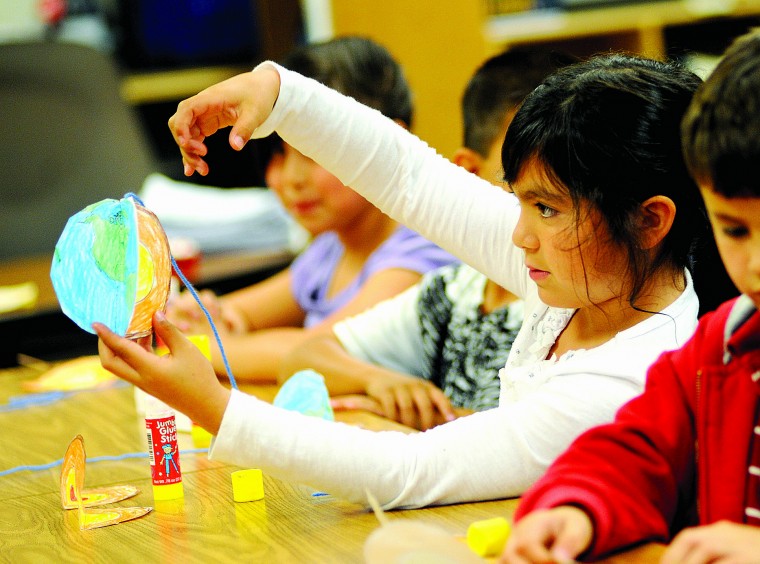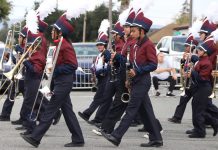
In one of two Thursday kindergarten classes at the Dual Language Academy, teacher Deanna Lane worked with students on the pronunciation of words – while displaying pictures of the objects – starting with the “sh” sound.
“This can be found in the water,” Lane told the students in English. “It’s very large and can hold a lot of people.”
Students were eager to give the answer – ship – along with other words in this lesson such as shell, sheep and shark.
Key to the five-year-old school’s success, though, is that the students appear just as eager to learn the same subjects in Spanish at this dual-immersion magnet institution on the Gabilan Hills campus. Reflecting the achievement of the budding school – though limited in growth by constraints of physical space – is the recent announcement it was among 387 schools statewide named as a 2012 California Distinguished School.
The honor awards schools for not only posting successful results on standardized testing, but also their commitments to “narrowing the achievement gap,” according to the California Department of Education announcement naming the winning schools. The 10-classroom Dual Language Academy has experienced steady success on API testing – including the 833 score in 2011 after scores of 799 and 842 the prior two years (the state’s goal is 800 for individual schools). Just as important is the focus on multiculturalism, one of the three goals of the school along with improving bi-literacy and bilingualism, said Principal Delia Gomez.
The Dual Language Academy launched in 2007 as one of two magnet schools in the Hollister School District – with the Accelerated Achievement Academy being the other.
“The school’s only been open for five years so, obviously, this is definitely an honor in terms of the short amount of time we’ve been doing our dual-language program,” Gomez said.
Aside from the highly trained staff’s dedication to achievement and establishing the foundation for bilingualism and bi-literacy – properly certified educators are “hard to come by,” she said – Gomez underscored the importance of the parents in the program that attracts a waiting list and lottery to choose the enrolled students.
“The expectation is that every parent will volunteer 30 hours per school year,” Gomez said. “We create opportunities for parents to be actively involved. They take active roles in terms of running a group, running a center. You see parents in the work room. Parents are here all the time. They’ve been key in our success as well.”
Those focused goals have set the stage for academic success, while Gomez and other officials at the school are keen on using the foundation to advance students’ language abilities and allow them to continue successfully at San Benito High School, which now offers a Seal of Bi-literacy on diplomas for those who earn it.
As a whole, the school is following through on a vision established in the mid-2000s by former Superintendent Ron Crates. The Dual Language Academy’s first group of students – first-graders when it started – will enter sixth grade next year. When that happens, the school will fill out its classrooms and be fully operational. It started with just kindergarten and first grade classes – each of which includes two teachers and follows a 30-to-1 teacher-to-student ratio.
“They had a desire to create a school in which they could demonstrate that kids could learn two languages simultaneously while gaining proficiency in all of the academic areas as well,” said current Superintendent Gary McIntire. “And they’ve done that.”
Gomez emphasized that API scores have improved gradually, but she also underscored the structure and programs that set apart the academy.
For each class, there are two groups. Rotating week to week, one will start with English in the morning and finish with classes in Spanish after lunch. Ideally, classes have about an equal proportion of English learners and English-only students, while Gomez said the ration now is 52 percent English learners.
Gomez was particularly proud of the culture aspect, though. The school focuses on the “international perspective,” she said. Next month, for example, is International Day, when grade levels will each do extensive study on a particular country and learn about the music, food and other cultural leanings in those places, with class subjects revolving around the topics.
Five years, meanwhile, has given the school leaders a chance to learn themselves. Gomez said they have absorbed the vast importance of staff training.
“The staff development is key in terms of ensuring the teachers are on board with the model,” she said. “It’s a team effort. It has to be a team effort.”
Editor’s note: The print edition of this story listed the incorrect API scores.









